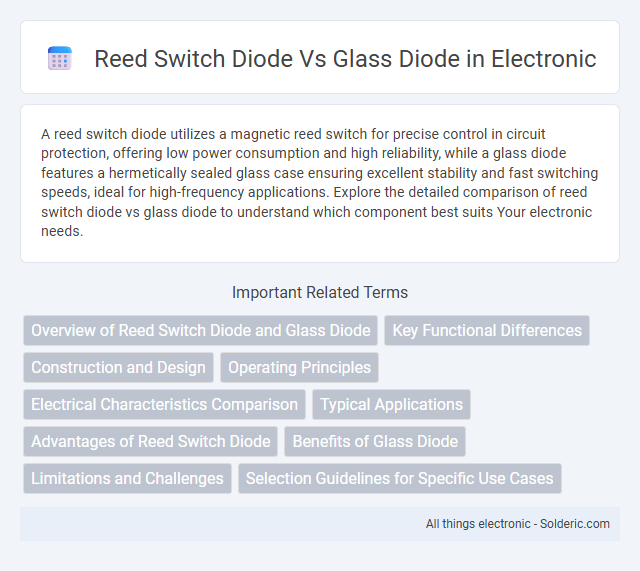A reed switch diode utilizes a magnetic reed switch for precise control in circuit protection, offering low power consumption and high reliability, while a glass diode features a hermetically sealed glass case ensuring excellent stability and fast switching speeds, ideal for high-frequency applications. Explore the detailed comparison of reed switch diode vs glass diode to understand which component best suits Your electronic needs.
Comparison Table
| Feature | Reed Switch Diode | Glass Diode |
|---|---|---|
| Construction | Magnetic reed contacts sealed in a glass tube | Semiconductor diode enclosed in a glass package |
| Functionality | Act as a switch triggered by magnetic fields | Allow current flow in one direction (rectification) |
| Typical Use | Magnetic sensing, reed relays, proximity sensors | Rectification, signal demodulation, protection circuits |
| Switching Speed | Relatively slow (milliseconds) | Fast switching (nanoseconds to microseconds) |
| Durability | Susceptible to contact wear over time | Long-lasting with no physical contact wear |
| Sensitivity | Activated by external magnetic fields | Unaffected by magnetic fields |
| Operating Voltage | Low voltage switching, typically under 200 V | Wide voltage range, up to several hundred volts |
Overview of Reed Switch Diode and Glass Diode
Reed switch diodes use a magnetic reed switch mechanism enclosed in a hermetically sealed glass tube to control electrical signals with low power consumption and high reliability. Glass diodes, typically referring to diodes encapsulated in glass packages, offer superior protection against environmental factors such as moisture and mechanical stress, enhancing longevity and performance. Your choice between these components depends on the specific application's need for magnetic switching sensitivity or robust environmental resistance.
Key Functional Differences
Reed switch diodes are magnetic field-activated switches consisting of ferromagnetic reeds sealed within a glass envelope, enabling contact closure when exposed to a magnetic field, while glass diodes are typically semiconductor devices enclosed in glass that control current flow by allowing it in one direction. Reed switch diodes operate as mechanical contacts responsive to magnetic fields, offering low resistance and high isolation in off-state, whereas glass diodes (such as glass-encapsulated rectifiers) rely on semiconductor junctions for rectification and voltage regulation. Key functional distinctions include the reed switch diode's dependency on external magnetic flux for activation versus the glass diode's electrical current conduction and its polarity-sensitive semiconductor behavior.
Construction and Design
Reed switch diodes feature a hermetically sealed glass envelope housing flexible magnetic reeds that close or open circuits through magnetic fields, ensuring durability and fast switching. Glass diodes are constructed with two semiconductor electrodes encased in a glass body, designed to provide stable electrical characteristics and high thermal resistance. Your choice depends on the need for mechanical movement in reed diodes or the solid-state reliability offered by glass-encased semiconductor diodes.
Operating Principles
Reed switch diodes operate by closing a pair of ferromagnetic contacts inside a sealed glass tube when exposed to a magnetic field, enabling current flow through the device. Glass diodes, typically glass-encapsulated semiconductor diodes, rely on semiconductor junctions to control current direction and voltage drop without mechanical movement. The operating principle of reed switch diodes involves magnetic actuation, whereas glass diodes function based on electronic charge carrier dynamics within the semiconductor material.
Electrical Characteristics Comparison
Reed switch diodes exhibit low forward voltage drop and fast switching speeds, making them ideal for sensitive signal detection, while glass diodes typically offer higher reverse voltage tolerance and better thermal stability. The leakage current in reed switch diodes is generally lower due to their sealed reed contacts, whereas glass diodes may experience slightly higher leakage but sustain reliable operation under high-voltage applications. Electrical resilience in reed switch diodes is often optimized for low-current circuits, contrasting with the robust voltage endurance of glass diodes used in power rectification.
Typical Applications
Reed switch diodes are commonly used in magnetic sensing applications, such as proximity sensors, security systems, and reed relay circuits, due to their reliable contact operation triggered by magnetic fields. Glass diodes, particularly glass-encapsulated diodes, excel in high-frequency, high-voltage, and high-temperature environments like RF circuits, surge protection, and power supply rectification because of their robust construction and low leakage current. Your choice between these two should consider the specific application requirements for sensitivity, environmental resistance, and electrical performance.
Advantages of Reed Switch Diode
Reed switch diodes offer superior durability and faster switching speeds compared to glass diodes, making them ideal for high-performance applications. Their hermetically sealed contacts provide excellent protection against environmental factors such as moisture and dust, enhancing reliability and lifespan. You benefit from stable operation and lower power consumption when using reed switch diodes in sensitive electronic circuits.
Benefits of Glass Diode
Glass diodes offer superior hermetic sealing compared to reed switch diodes, ensuring enhanced protection against moisture and contaminants. These diodes provide higher reliability and longer lifespan due to the robust glass encapsulation, which resists thermal and mechanical stress effectively. Choosing a glass diode for your circuits improves overall performance by maintaining stable electrical characteristics under harsh environmental conditions.
Limitations and Challenges
Reed switch diodes present limitations such as lower switching speeds and sensitivity to external magnetic fields, which can affect reliability in precision applications. Glass diodes, while offering better hermetic sealing and durability, face challenges with higher thermal resistance and slower response times under rapid switching conditions. Your choice between these components depends on balancing environmental robustness against switching performance requirements.
Selection Guidelines for Specific Use Cases
Reed switch diodes offer high sensitivity and fast switching suitable for precise magnetic sensing applications, whereas glass diodes provide enhanced durability and moisture resistance, ideal for harsh environmental conditions. When selecting your component, consider reed switch diodes for low-power, high-speed signal detection, and glass diodes for robust performance in industrial or outdoor settings. Match the switch type to your device's operational environment and electrical requirements for optimal functionality.
Reed switch diode vs glass diode Infographic

 solderic.com
solderic.com